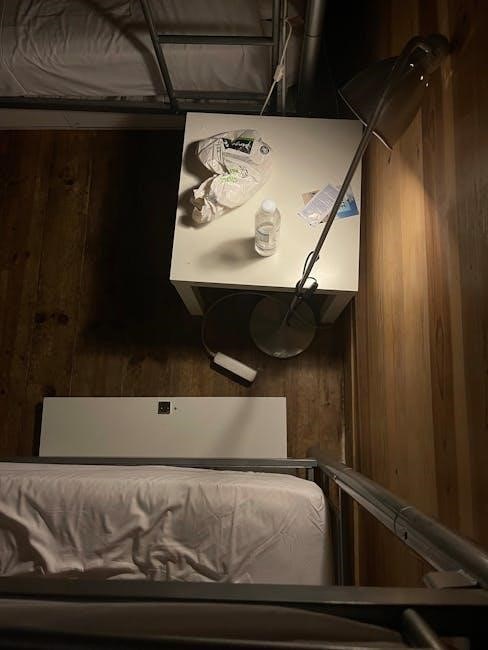Before embarking on the journey of constructing your wooden bunk bed‚ this guide will walk you through each stage. Assembly instructions are provided‚ ensuring a safe and sturdy end product. Follow each step carefully for best results.
Preparation Before Assembly
Prior to commencing the assembly of your wooden bunk bed‚ diligent preparation is paramount for a seamless and efficient process. Begin by carefully unpacking all components‚ ensuring each piece is accounted for and free from damage. Consult the provided parts list to verify the completeness of the inventory. Clear a spacious area‚ preferably in the room where the bunk bed will reside‚ to facilitate ease of movement and prevent accidental scratches or dents during assembly.
Protect the floor with a drop cloth or cardboard to avoid any potential damage. Gather all necessary tools‚ such as a screwdriver (both Phillips head and flathead)‚ an Allen wrench (if required)‚ a rubber mallet‚ and a level. Familiarize yourself with the assembly instructions‚ paying close attention to diagrams and specific steps. Sort and organize the hardware‚ such as screws‚ bolts‚ and dowels‚ to ensure quick access during the assembly process.
Adequate lighting is crucial for clear visibility‚ so ensure the workspace is well-lit. Enlist the assistance of another person‚ as some steps may require two individuals for safety and ease of handling. By meticulously completing these preparatory steps‚ you’ll set the stage for a smooth and successful bunk bed assembly experience.
Checking Parts and Hardware Inventory
Before initiating the physical assembly of your wooden bunk bed‚ a meticulous inventory check is absolutely crucial. Unpack all components from their packaging and lay them out in an organized manner on a protected surface. Cross-reference each item with the parts list provided in the assembly instructions‚ ensuring that every piece is present and accounted for. Pay close attention to the quantity and dimensions of each part‚ noting any discrepancies or missing items.
Next‚ carefully examine the hardware package. Separate and identify all screws‚ bolts‚ dowels‚ and other fasteners‚ comparing them to the hardware list. Verify that you have the correct number of each type of fastener and that they are in good condition‚ free from defects or damage. If any parts or hardware are missing or damaged‚ contact the manufacturer or retailer immediately to request replacements.

Do not proceed with the assembly until all necessary components are on hand. This thorough inventory check will prevent frustration and delays later in the process‚ ensuring a smooth and efficient bunk bed assembly experience. Taking the time to verify the contents beforehand is an investment in a successful outcome.
Tools Required for Assembly
Before diving into the assembly of your wooden bunk bed‚ gathering the necessary tools is paramount for a smooth and efficient process. Essential tools include a Phillips head screwdriver‚ which will be needed for securing various screws and fasteners throughout the assembly. An Allen wrench‚ often included with the bunk bed kit‚ is crucial for tightening bolts that connect the frame components.
A rubber mallet can be helpful for gently tapping wooden dowels into place without damaging the wood. A level is indispensable for ensuring that the bunk bed is perfectly horizontal‚ guaranteeing stability and safety. Measuring tape will be needed to verify dimensions and alignment during the assembly process.
A power drill with various drill bits can expedite the process‚ but use it cautiously to avoid over-tightening screws or stripping threads. Safety glasses are recommended to protect your eyes from flying debris. Having these tools readily available will streamline the assembly‚ minimize frustration‚ and ensure a secure and well-constructed wooden bunk bed. Consider having a second person to assist‚ particularly when lifting heavier components.
Assembling the Bottom Bed Frame
The first step in building your bunk bed is assembling the bottom bed frame. Begin by laying out all the necessary components‚ including the side rails‚ headboard‚ and footboard. Refer to the manufacturer’s instructions to identify each part and its proper orientation. Typically‚ the headboard and footboard will have pre-drilled holes or marked locations for attaching the side rails.
Align the side rails with the headboard and footboard‚ ensuring that they are flush and properly aligned. Insert the appropriate screws or bolts into the pre-drilled holes‚ using a screwdriver or Allen wrench to tighten them securely. It is important to avoid over-tightening‚ as this can damage the wood.
Repeat the process for all four corners of the frame‚ ensuring that each connection is tight and stable. Once the frame is assembled‚ double-check that all screws and bolts are securely fastened. If wooden dowels are used for additional support‚ insert them into the corresponding holes before tightening the screws. With the bottom bed frame now assembled‚ you have a stable foundation to continue building your bunk bed.
Installing Wooden Dowels
After assembling the bottom bed frame‚ the next crucial step is installing the wooden dowels. These small cylindrical pieces of wood are used to reinforce the joints between the bed frame components‚ providing added stability and preventing wobbling. Before you begin‚ ensure you have the correct size and quantity of dowels as specified in the assembly instructions.
Locate the pre-drilled holes in the bed frame where the dowels are to be inserted. These holes are typically found on the inside surfaces of the headboard‚ footboard‚ and side rails. Apply a small amount of wood glue to the inside of each hole to ensure a secure and lasting bond. Gently insert the wooden dowels into the holes‚ making sure they are fully seated and flush with the surface of the wood.
If the dowels are too tight to insert by hand‚ use a rubber mallet to lightly tap them into place. Be careful not to damage the dowels or the surrounding wood. Once all the dowels are installed‚ allow the glue to dry completely before proceeding to the next step. This will ensure that the joints are strong and stable.
Attaching the Bed Rails
With the wooden dowels securely in place‚ the next step involves attaching the bed rails to the assembled headboard and footboard. The bed rails provide the structural support for the mattress and connect the two ends of the bed frame. Before you begin‚ ensure that you have the correct bed rails for your specific bunk bed model.
Align the bed rails with the corresponding slots or brackets on the inside of the headboard and footboard posts. Depending on the design of your bunk bed‚ the bed rails may attach using screws‚ bolts‚ or a hook-and-slot system. If using screws or bolts‚ insert them through the pre-drilled holes in the bed rails and tighten them securely with a screwdriver or wrench. Make sure the bed rails are flush against the headboard and footboard for maximum stability.
If your bunk bed uses a hook-and-slot system‚ simply slide the hooks on the bed rails into the slots on the headboard and footboard. Ensure that the hooks are fully engaged and locked into place; Once the bed rails are attached‚ double-check that they are level and securely fastened. This is crucial for the safety and stability of the bunk bed.
Inserting the Bed Slats
With the bed rails securely attached‚ the next crucial step is inserting the bed slats. These slats provide essential support for the mattress and distribute weight evenly across the bed frame. Before you begin‚ ensure you have the correct number of slats and that they are the appropriate length for your bunk bed model.

Start by positioning the first slat at one end of the bed frame‚ resting it on the ledges or supports along the inside of the bed rails. Ensure that the slat is evenly spaced and flush against the frame. Most bunk beds use either individual slats or a linked slat system. If using individual slats‚ space them evenly across the frame‚ maintaining a consistent gap between each slat.
If your bunk bed uses a linked slat system‚ simply unroll the connected slats and position them across the bed frame. The links will ensure even spacing and alignment. Once all the slats are in place‚ double-check that they are securely resting on the supports and that there are no gaps or loose areas. For added security‚ some models may require screwing the slats into the frame.
Assembling the Top Bunk Frame
Now that the bottom bunk frame is stable and ready‚ it’s time to focus on assembling the top bunk. This process mirrors the assembly of the bottom bunk‚ with a few key differences to ensure safety and stability at a higher elevation. Begin by gathering the necessary components for the top bunk frame‚ including the headboard‚ footboard‚ side rails‚ and any additional support pieces.
Lay out the components on a flat‚ protected surface‚ such as a carpet or blanket‚ to prevent scratches or damage. Refer to the manufacturer’s instructions to identify the correct orientation of each piece. Attach the side rails to the headboard and footboard using the provided hardware‚ typically bolts and screws. Ensure all connections are tight and secure.
Depending on the design‚ the top bunk may have additional safety features‚ such as guardrails or support beams. Install these components according to the instructions‚ paying close attention to the placement and orientation. Double-check all connections and ensure that the top bunk frame is structurally sound before proceeding to the next step.
Connecting the Top Bunk to the Bottom Bunk
With both the top and bottom bunk frames assembled‚ it’s time to connect them‚ creating the bunk bed structure. This step is crucial for stability and safety‚ so proceed with caution and ensure all connections are secure. Before lifting the top bunk‚ clear the surrounding area to provide ample workspace and prevent accidents. Recruit a helper to assist with lifting and aligning the top bunk onto the bottom bunk.
Carefully lift the top bunk frame and position it above the bottom bunk. Align the posts of the top bunk with the corresponding receiving points on the bottom bunk. Slowly lower the top bunk onto the bottom bunk‚ ensuring the posts fit securely into place. Once aligned‚ use the provided hardware‚ typically bolts and screws‚ to connect the two bunk frames.
Tighten all connections securely‚ but avoid over-tightening‚ which could damage the wood. Double-check the alignment of the bunks and make any necessary adjustments before fully tightening the hardware. Once connected‚ the bunk bed should be stable and secure‚ with no wobbling or shifting.
Installing the Ladder
The ladder provides access to the top bunk and must be securely attached to the bed frame. Before starting‚ identify the designated location for the ladder‚ typically on one end of the bunk bed. Align the ladder with the bunk bed frame‚ ensuring the rungs face outward for easy climbing. Most ladders attach using screws or bolts‚ so locate the pre-drilled holes on both the ladder and the bunk bed frame.

Insert the screws or bolts through the ladder supports and into the corresponding holes on the bed frame. Tighten the fasteners securely‚ but avoid over-tightening‚ which could damage the wood or strip the screw threads. Ensure the ladder is level and stable before fully tightening all connections.
Some ladders may have additional support brackets or safety features. Install these according to the manufacturer’s instructions. Double-check that the ladder is firmly attached and can support weight without wobbling or shifting. Once installed‚ test the ladder by climbing up and down to ensure it is safe and comfortable to use. Make any necessary adjustments to ensure stability and ease of access to the top bunk.

Safety Considerations During Assembly
Assembling a wooden bunk bed requires careful attention to safety to prevent injuries and ensure the bed’s stability. Start by ensuring the assembly area is clear of obstacles and has ample space to maneuver around the components. Always work with a partner to lift and position heavy parts‚ reducing the risk of strains and drops. Wear appropriate personal protective equipment‚ such as gloves and safety glasses‚ to protect your hands and eyes from splinters and debris.
Carefully inspect all parts for damage before assembly. Do not use damaged components‚ as they could compromise the bed’s structural integrity. Follow the manufacturer’s instructions closely‚ and do not skip steps or modify the assembly process. Ensure all screws‚ bolts‚ and fasteners are properly tightened to prevent wobbling or collapse.
Pay close attention to ladder installation and safety rails‚ ensuring they are securely attached and meet safety standards. If children are present during assembly‚ keep them away from the work area to prevent accidents. After assembly‚ double-check all connections and conduct a thorough inspection to ensure the bed is stable and safe for use. Adhering to these safety considerations will ensure a smooth and secure bunk bed assembly process.
Tightening Bolts and Screws
Ensuring that all bolts and screws are properly tightened is crucial for the stability and safety of your wooden bunk bed. Begin by using the appropriate tools‚ such as Allen wrenches or screwdrivers‚ as specified in the assembly instructions. Tighten each fastener gradually‚ avoiding excessive force that could strip the threads or damage the wood. Follow a systematic approach‚ starting with the main structural components and then moving to smaller parts.
After initially tightening all fasteners‚ go back and double-check each one to ensure they are snug. Pay particular attention to the bolts connecting the bed frames and ladder supports‚ as these areas bear the most weight. If a bolt or screw feels loose‚ try tightening it further; If it continues to slip‚ inspect the threads for damage and replace the fastener if necessary.
Regularly check the tightness of bolts and screws‚ especially during the first few weeks of use‚ as the wood may settle and compress. Over time‚ vibrations and movement can cause fasteners to loosen‚ so periodic maintenance is essential. By diligently tightening all bolts and screws‚ you can ensure the long-term stability and safety of your wooden bunk bed‚ providing a secure sleeping environment.
Final Inspection and Placement
Before declaring your wooden bunk bed assembly complete‚ a thorough final inspection is crucial. Systematically examine every connection‚ joint‚ and component. Ensure all bolts and screws are tightened securely‚ with no wobbling or instability. Double-check that the ladder is firmly attached and can bear weight safely. Inspect the bed slats to guarantee they are properly spaced and securely positioned within the frame.
Assess the overall structural integrity‚ looking for any signs of stress or weakness. If you identify any issues‚ revisit the relevant assembly steps and rectify them immediately. Once you are satisfied with the bunk bed’s sturdiness‚ carefully consider its placement within the room. Ensure adequate headroom above the top bunk and sufficient space around the bed for safe movement.
Avoid placing the bunk bed near windows‚ heaters‚ or other potential hazards. Use a level to verify that the bed is sitting evenly on the floor‚ making adjustments as needed. Finally‚ install any safety rails or barriers as required‚ ensuring they are securely fastened. By conducting a meticulous final inspection and thoughtfully positioning the bunk bed‚ you can create a safe and functional sleeping space.



